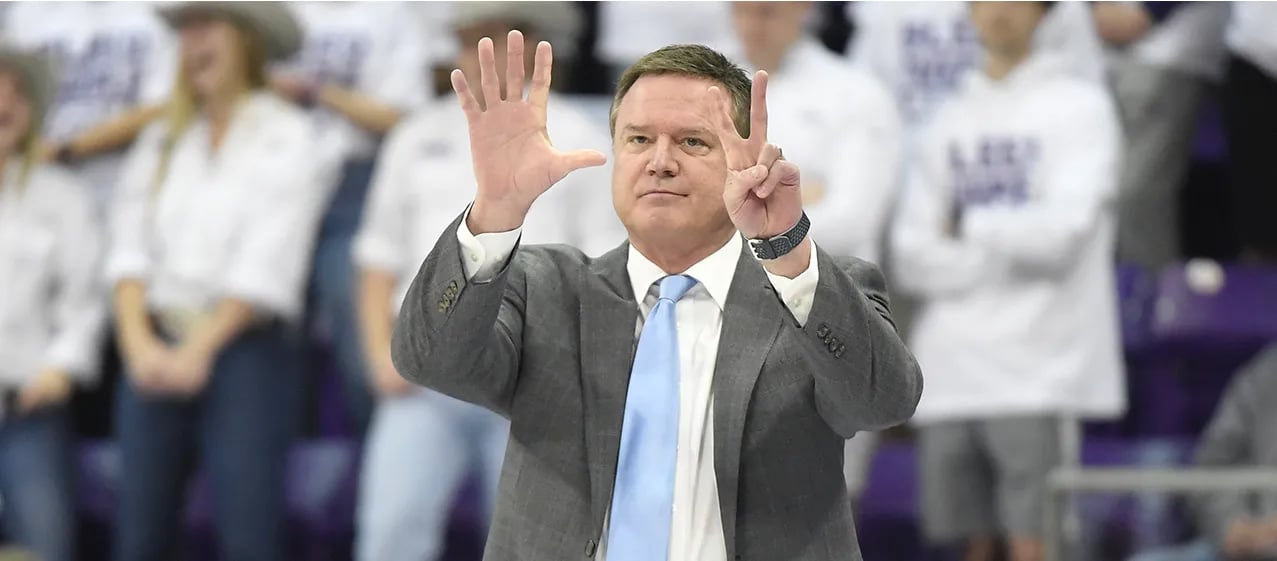Is This Bill Self's Best Defense... Ever?
Plus: are intentionally missed FTs an opportunity for #disruption?
Photo courtesy of KU Athletics
While it ended up being career win #700 for Bill Self, Saturday’s afternoon tilt @ TCU was an unmemorable game. A first-half Udoka Azubuike free-for-all slowed down in the second half. While TCU was able to heave its way within four, a Marcus Garrett steal triggered a 12-0 run and the game was over. I’m going to echo some Chiefs canon here, but this year’s group seems to find ways to win when things aren’t perfect. While any paranoid KU fan still wakes up in a cold sweat thinking about a random 11-seed getting hot from three in the NCAA tournament, KU has college basketball’s number one defense. It may very well be our meal ticket.
TCU stinks—I’ll put that out there so no one questions it. But on Saturday, they had a .70 PPP—it took them an average of three trips to get two points. That’s ridiculous. Jesse Newell’s gamer drills down on it even more, making an important point: despite Self’s reputation, he’s had the nation’s year-end top defense only once before. That was 2008, where something very good happened.
That the defense is this prestigious is encouraging on a number of levels, because basically no one throughout college is that good at offense right now. With Doke’s emergence as a shot blocker, KU has even more options on defense than it did last year. They can switch around, and take more risks at the perimeter, which is great news for hands-y KU defenders like Devon Dotson and Marcus Garrett who have made game-saving plays freelancing as of late. Isaiah Moss has been kind of a disappointment to me (he’s 23… shouldn’t he have a better feel for the flow of a game by now?), but he’s held his own so far, too, on that end of the floor—having everything flow to the shotblocker is a nice way to hide weaker defenders.
It’s a different game than it was in 2008, with more emphasis on stretching the floor and shooting. But, everyone knows that’s how you need to beat KU, and yet few teams have been able to really puncture their defense. It’s perfectly OK to feel nervous about our offense, which can’t do much when passing lanes to Doke are clogged up. But the defense is legit.
On Wednesday night, KU will face the nation’s second best defense—West Virginia.
Hacking Basketball, One Free Throw at a Time
Watching Duke and UNC on Saturday night—game good!—got me thinking a little about intentionally missed free throws. In the past month, we’ve seen two of the better attempts ever (De’Aaron Fox’s is the GOAT, a symphony of perfect movements). Both plays completely flipped the game.
Here’s Jones ICYMI:
Is there something to this? Is there a white space here?
Trends in basketball are fluid. While there’s a full-blown panic in the NBA about the state of the traditional big man, the larger story is about matchups: to improve performance, playoff contenders look to solidify strengths and hide weaknesses. It’s all about efficiency and optimization. Every team or organization is looking for a Moneyball insight, a loophole only they can see—one that ideally doesn’t involve banging a baseball bat into a trash can.
Right now, KU is 295th in FT%, which, lol. I doubt anyone is too surprised by that, because the stripe has always been a source of anxiety during the Self era. But is there a world where we make our sub-average free throw shooting an asset?
Here’s Tre Jones on the execution of the free throw miss at the end of regulation, one he corralled before tying the game on an elbow jumper:
The roots of that successful play go back a few weeks when Jones was spending extra time working on making free throws. But Scheyer brought up a different scenario — what would you do if you had to intentionally miss?
So often, Scheyer and Jones discussed, the attempt to intentionally miss causes the ball to bank in the basket. Or the attempt misses the rim altogether, a violation that gives the other team possession.
To counter that, Scheyer said, he told Jones to take a step to the right from where he normally shoots his free throws.
UNC thrust Jones into a situation that called for that play.
For the fateful attempt, Scheyer instructed Jones to take a step to his right—this would help him be in position when the ball caromed back above the free throw line. Of course Jones—a 75% free throw shooter—had practiced this. It saved them the game, and made an already grim UNC season that much grimmer.
Fox’s attempt is much more precise, and it is truly divine. He squares the underside of the rim, and the result is essentially a laser pass right back to Fox, who is leaning toward the goal. No one else has a chance at the ball, and Fox scoops it in to send the Kings into OT, where they would eventually win.
I’m not suggesting that KU’s worst foul shooters will be able to execute with the precision of these guards, both of whom are good-to-very-good foul shooters. But maybe there’s a less skill-intensive version of the shot, or a new alignment around the lane area.
All KU fans grumble about our free throw shooting. All I’m asking is, what if it somehow became an asset? If anyone from the KU coaching staff is reading this, I am available for any open positions.



